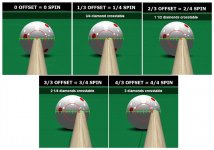What does that image look like with say a 12mm tip & max LH English.
Seems I'm further out that your outer circle but I can't lay my tip on there to see what it would look like.
That image is points of contact, so in your case you won't be using your tip center for point of contact (guessing ~5mm from edge).I imagine to you it looks like the outer most edge of cue and ball are about 6mm away or eclipsing 6mm.
Somebody around here has done all this work already based on actual evidence, I've seen it years back but can't find it.



